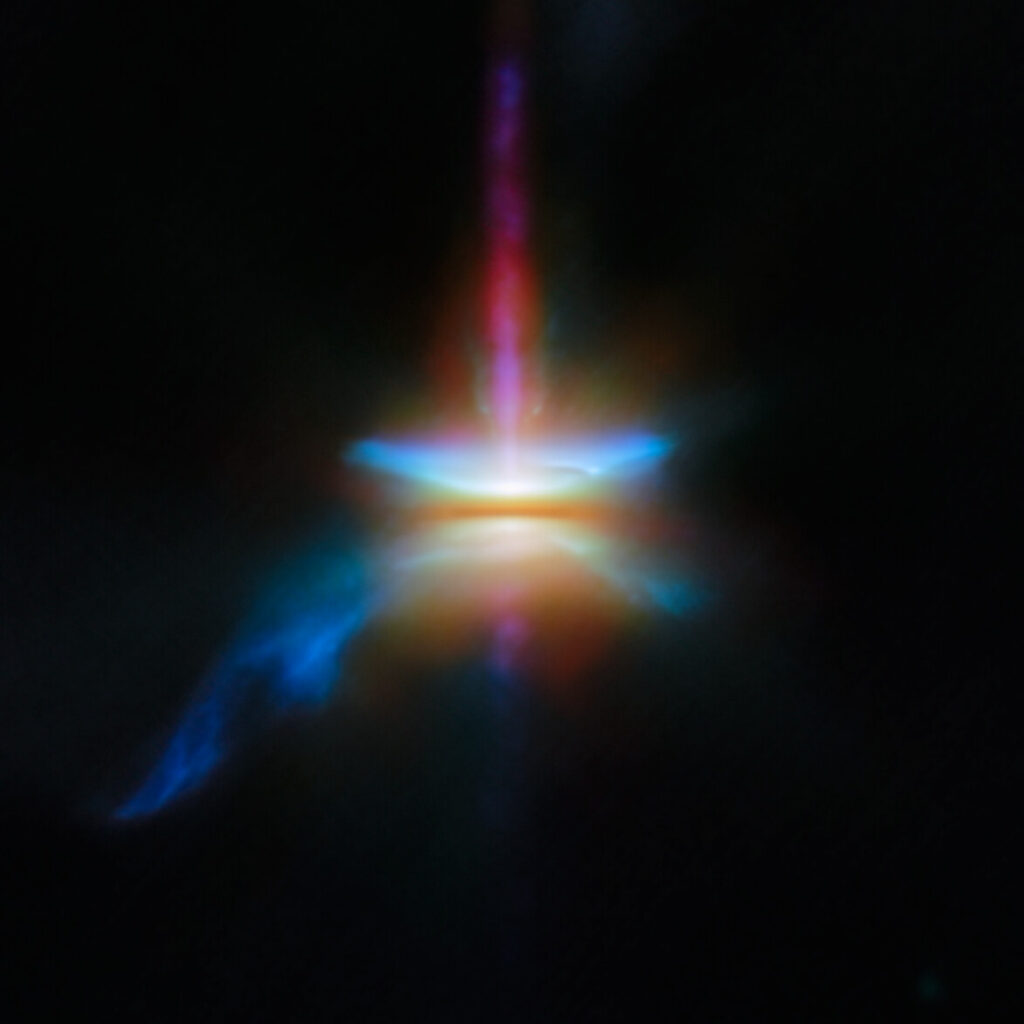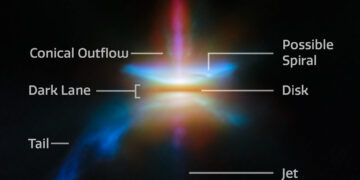The James Webb Space Telescope (JWST) has once again unveiled a fascinating secret of the universe. This time, its powerful infrared vision has captured an unprecedented view of HH 30, a protoplanetary disc located in the Taurus Molecular Cloud. The image, released by NASA and the European Space Agency (ESA), reveals an edge-on structure with striking features—jets, outflows, and a dark, dusty band obscuring the young star at its core.
What is HH 30?
HH 30 is a well-known example of an edge-on protoplanetary disc, making it a prime target for astronomers studying planet formation. Unlike many protoplanetary discs viewed from above, HH 30 appears edge-on from Earth, meaning we can observe its layers and structures with remarkable clarity.

The core of HH 30 is hidden by a thick, dark dust band, which represents the densest part of the disc. This is where tiny stellar dust grains begin clumping together, a crucial step in the process that eventually leads to planet formation. Above and below this band, powerful jets and outflows are visible, a common feature in young stellar objects as material is ejected from the system.
How Webb Captured HH 30 in Stunning Detail
Using a combination of infrared wavelengths, JWST has provided the most detailed view of HH 30 ever seen. Different colors in the image represent different wavelengths of light, helping astronomers decode the physical properties of the dust, gas, and stellar material within the disc.
Previous observations using the Hubble Space Telescope and the Atacama Large Millimeter/Submillimeter Array (ALMA) provided significant insights into HH 30. However, JWST’s advanced sensitivity allows it to detect even smaller dust particles and track their movement within the disc, revealing new details about how material migrates and accumulates.
The Importance of Dust in Planet Formation
At the heart of HH 30’s significance is the role of dust grains. These microscopic particles, which are just a millionth of a meter across—about the size of a single bacterium—are the fundamental building blocks of planets.
Observations of HH 30 show that dust grains settle into a thin layer within the disc. Over time, they begin to stick together, forming pebbles, then planetesimals, and eventually full-sized planets.
The Role of Jets and Outflows
One of the most visually striking features of HH 30 is the presence of high-velocity jets and swooping outflows. These jets are streams of charged particles that are ejected from the poles of the young star, cutting through the surrounding material and shaping the disc’s evolution.
The presence of these outflows suggests that the young star is actively accreting material from its surroundings. This accretion process is responsible for the intense energy observed in the system, as material spirals into the star, heating up and emitting powerful radiation. The jets also serve as a stabilizing force, preventing the disc from collapsing inward too quickly and helping distribute angular momentum.
What Makes HH 30 Special?
HH 30 is a unique system because it provides a nearly perfect edge-on view, allowing astronomers to analyze each layer of the disc with exceptional clarity. This makes it an ideal subject for studying how dust behaves and migrates in early planetary systems.
Additionally, HH 30 is one of the best examples of how stellar outflows interact with surrounding material, providing clues about the forces that shape young planetary systems. The ability to observe how dust settles and how jets interact with their surroundings gives scientists a clearer picture of how planets form and evolve.
Implications for Our Understanding of Planet Formation
The study of HH 30 contributes significantly to our broader understanding of planet formation. By analyzing the behavior of dust grains and their migration within the disc, astronomers can refine their models of how planetary systems develop.
One of the key takeaways from this observation is that dust grains are not static; they move, settle, and undergo complex interactions that determine whether a planet will eventually form.
The Future of Protoplanetary Disc Studies
JWST’s ability to capture high-resolution images of HH 30 is just the beginning. The telescope will continue to observe similar systems, comparing different protoplanetary discs to understand their unique characteristics and common patterns.
Conclusion
The James Webb Space Telescope’s latest image of HH 30 is not just another stunning snapshot of the cosmos—it’s a crucial piece of the puzzle in our understanding of how planets form. By capturing the dynamics of dust grains, jets, and outflows, JWST is helping scientists piece together the complex processes that lead to the birth of planetary systems.



















